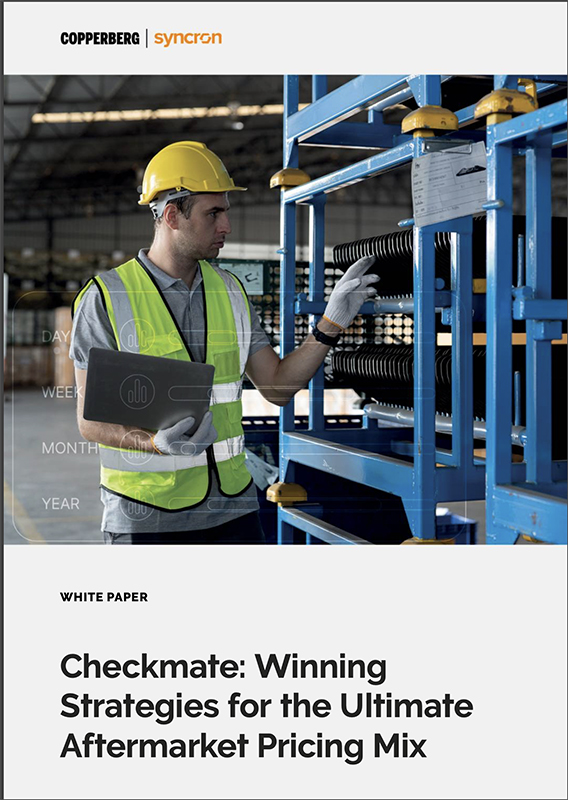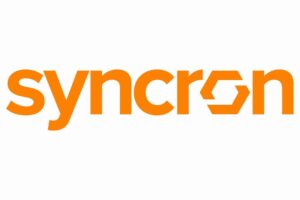Rethinking Industrial Pricing for Sustainable Profitability
Kris Oldland, Editor-in-Chief, reflects on the recent Copperberg White Paper, Checkmate: Winning Strategies for the Ultimate Aftermarket Pricing Mix, and offers his insights into the key takeaways of this excellent and thought-provoking paper…
Having recently published a paper in partnership with Syncron that explores the need for rethinking our approaches to industrial pricing in the face of ongoing disruption across the manufacturing sector, I’ve had the opportunity to reflect on the most salient points that emerged from this exploration of what is an increasingly important discussion.
In this brief article I’ll offer my cliff notes on the ten most important takeaways from the paper.
Embracing Intelligent Pricing in the Industrial Sector:
In the evolving industrial sector, the traditional cost-plus pricing model for spare parts is becoming increasingly inadequate. This model, which adds a markup to the manufacturing cost to ensure a profit margin, fails to consider market dynamics and customer perceptions. As the industry shifts towards everything-as-a-service (XaaS), it’s imperative to adopt more sophisticated pricing strategies to maintain profitability and customer loyalty.
Indeed, from my own discussions with industry leaders and analysts, it’s clear that the reliance on outdated pricing methods is a significant barrier to growth. I have heard more than one anecdote about how a company’s rigid pricing structure has led to losing a key client to a more flexible competitor. This underscores the need for a shift towards more intelligent pricing.
Limitations of the Cost-Plus Model:
To be blunt, the cost-plus model is outdated in today’s competitive environment.
It focuses solely on production costs and fixed profit margins, ignoring market conditions and customer expectations. This often leads to misaligned prices, resulting in profit leaks and diminished customer satisfaction. As competitors implement more dynamic pricing strategies, sticking to the cost-plus model can render organizations uncompetitive and disconnected from market realities.
In particular, I recall a case study involving a major automotive parts supplier I worked with recently, who struggled with inventory overstock and underpricing issues (something thatis more prevalent an issue than one may imagine). By failing to adapt their pricing to market conditions, they missed out on significant revenue opportunities, and such revenue leakage, in the current market environment needs to be addressed across the board.
Complexities of Spare Parts Pricing:
Pricing spare parts is inherently complex due to the variety of components, differing lifecycles, and unpredictable demand. Factors such as equipment failure rates, maintenance schedules, and technological advancements influence demand, making it challenging to set appropriate prices using traditional models. Moreover, managing global pricing across diverse markets with fluctuating conditions adds another layer of difficulty.
In conversations with supply chain managers, they frequently express frustration over the challenges of setting and adjusting prices for thousands of SKUs. As one spare parts manager explained to me once, “It’s like trying to hit a moving target with one eye closed.”
Effective parts pricing for many years was something of a dark art, but fortunately, we are entering an age where technology can ease a lot of the complexity.

 Data usage note: By accessing this content you consent to the contact details submitted when you registered as a subscriber to fieldservicenews.com to be shared with the listed sponsor of this premium content Syncron who may contact you for legitimate business reasons to discuss the content of this briefing report.
Data usage note: By accessing this content you consent to the contact details submitted when you registered as a subscriber to fieldservicenews.com to be shared with the listed sponsor of this premium content Syncron who may contact you for legitimate business reasons to discuss the content of this briefing report.
This content is available for FSN PRO members and also for a limited period for FSN FREE members. Please make sure you are logged in to access this content.
Not yet subscribed? Instantly unlock this content and more on our forever-free subscription tier FSN FREE
"The stark reality is that the traditional cost-plus pricing model is simply no longer suitable in today's modern manufacturing landscape..."
Benefits of Data-Driven Pricing Strategies:
To overcome these challenges, organizations absolutely must adopt intelligent, data-driven pricing strategies that leverage advanced analytics and real-time data. These strategies offer several advantages:
- Maximizing Profit Potential:
By aligning prices with the customer’s willingness to pay, organizations can optimize profit margins. Understanding the value customers place on different parts and services allows manufacturers to set competitive yet profitable prices.
- Enhancing Customer Satisfaction:
Fair pricing aligned with perceived customer value enhances satisfaction and loyalty, crucial for sustained success in the aftermarket sector.
- Creating a Competitive Edge:
Intelligent pricing enables quick responses to market shifts and competitive pressures. By continuously monitoring market conditions, manufacturers can dynamically adjust prices, maintaining a competitive edge.
- Optimizing Inventory Management:
Accurate demand forecasting through data-driven pricing improves inventory management, reducing risks associated with overstocking or stockouts.
Shifting Towards Strategic Pricing:
The stark reality is that the traditional cost-plus pricing model is simply no longer suitable in today’s modern manufacturing landscape. Intelligent, data-driven strategies offer a compelling alternative, addressing the limitations of cost-plus models. My own experience in the industry has shown me that leveraging advanced analytics and real-time data can significantly enhance profitability, customer satisfaction, and inventory management, strengthening competitive positions.
"Advanced pricing software solutions provide real-time insights into customer preferences and market trends. Transparent pricing practices build trust and credibility with customers..."
Pricing Intangible Service Offerings:
Pricing intangible services presents unique challenges compared to tangible goods. Services lack clear production costs and measurable indicators, making it difficult to establish standard pricing frameworks. Customers evaluate services based on subjective factors such as interaction quality, expertise, and outcomes. This requires a deep understanding of customer expectations and greater flexibility within our approach to pricing.
I’m very fortunate in my working life to spend time every day talking with very smart and forward thinking service leaders, and one of the consistent themes I hear emphasized is the importance of understanding customer perceptions. One manager remarked, “It’s not just about the service itself but the value we bring to their operations.”
Effective Pricing Strategies for Intangible Offerings:
The white paper outlines a strategic roadmap for pricing intangible service offerings based on three principles:
- Understanding Customer Expectations:
Analyzing customer data to identify patterns and preferences allows for tailored service offerings and pricing strategies, enhancing customer satisfaction and loyalty.
- Quantifying Service Value:
Moving beyond cost considerations, manufacturers should adopt value-based pricing, focusing on tangible outcomes and unique value propositions. Effective communication of added value to customers is crucial.
- Leveraging Technology and Transparency:
Advanced pricing software solutions provide real-time insights into customer preferences and market trends. Transparent pricing practices build trust and credibility with customers.
Integrating AI in Aftermarket Pricing:
AI and Machine Learning (ML) can revolutionize aftermarket pricing strategies. Unlike traditional methods, AI-driven models optimize pricing by considering factors like demand, inventory levels, and competitor pricing. This approach enhances service levels, cost efficiency, and profitability.
"By leveraging AI, advanced analytics, and continuous innovation, manufacturers can optimize pricing, enhance service levels, and maintain a competitive edge in the aftermarket business..."
Advanced Pricing Solutions and Data Analytics:
Similarly, advanced pricing solutions and data analytics are essential for capturing customer value and optimizing pricing decisions. By analyzing customer interactions, transaction histories, and market trends, manufacturers can set prices that reflect true customer value. Real-time insights enable agile decision-making, ensuring competitiveness.
Continuous Innovation and Differentiation:
Continuous innovation and differentiation are vital for maintaining a competitive edge. By consistently innovating products and services, manufacturers can meet evolving customer expectations and attract new customers. Differentiating through a strong value proposition allows organizations to stand out and justify higher prices.
Final Observations:
In the fast-paced industrial sector, traditional pricing models are simply no longer sufficient. Adopting intelligent, data-driven pricing strategies is now essential for sustainable profitability and customer satisfaction. By leveraging AI, advanced analytics, and continuous innovation, manufacturers can optimize pricing, enhance service levels, and maintain a competitive edge in the aftermarket business.
Indeed, many of my personal discussions with industry leaders would corroborate this and confirm that embracing these transformative technologies and strategic approaches is crucial for future success.
Do you want to know more?
If you want to read more from this paper then you can access it instantly on the button below if you have a sufficient membership. If you don’t have the right membership privileges then you can register on the button below for instant access.
This content is available for FSN PRO members and also for a limited period for FSN FREE members. Please make sure you are logged in to access this content.
Not yet subscribed? Instantly unlock this content and more on our forever-free subscription tier FSN FREE


Data usage note: By accessing this content you consent to the contact details submitted when you registered as a subscriber to fieldservicenews.com to be shared with the listed sponsor of this premium content Syncron who may contact you for legitimate business reasons to discuss the content of this briefing report.


